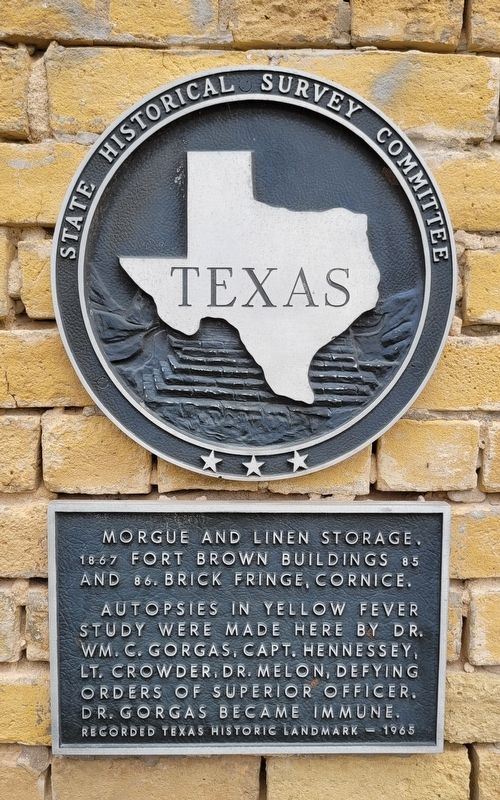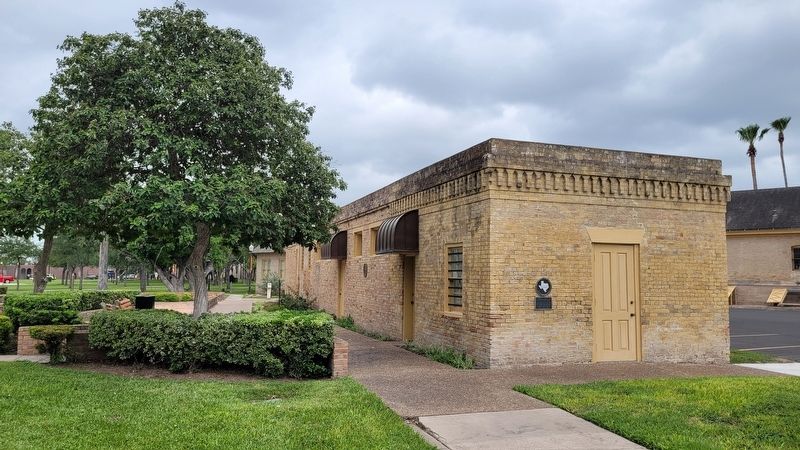Brownsville in Cameron County, Texas — The American South (West South Central)
Fort Brown Buildings 85 and 86
Old Morgue
Erected 1965 by State Historical Survey Committee. (Marker Number 1964.)
Topics. This historical marker is listed in these topic lists: Forts and Castles • Science & Medicine. A significant historical year for this entry is 1867.
Location. 25° 53.906′ N, 97° 29.504′ W. Marker is in Brownsville, Texas, in Cameron County. Marker can be reached from Gorgas Drive, 0.2 miles south of Taylor Avenue. The marker is located on the west side of the "Old Morgue" building on the campus of Texas Southmost College. Touch for map. Marker is at or near this postal address: 1821 Gorgas Dr, Brownsville TX 78520, United States of America. Touch for directions.
Other nearby markers. At least 8 other markers are within walking distance of this marker. Post Morgue (a few steps from this marker); Fort Brown Commissary/Guardhouse (within shouting distance of this marker); William Crawford Gorgas (within shouting distance of this marker); Commissary (within shouting distance of this marker); Fort Brown Commissary / Guardhouse Comisaria y Casa de la Guardia del Fuerte Brown (within shouting distance of this marker); Post Hospital (within shouting distance of this marker); African American Troops at Fort Brown (within shouting distance of this marker); Post Hospital Annex (within shouting distance of this marker). Touch for a list and map of all markers in Brownsville.
More about this marker. The historic Fort Brown buildings are located around the campus of the Texas Southmost College.
Also see . . .
1. Fort Brown. Texas State Historical Association (TSHA)
Fort Brown, originally called Fort Texas, was established when Zachary Taylor and the United States forces of occupation arrived on the Rio Grande on March 26, 1846, to establish the river as the southern boundary of Texas. In April 1846 Taylor built an earthen fort of 800 yards perimeter, with six bastions, walls more than nine feet high, a parapet of fifteen feet, and the whole surrounded by a ditch fifteen feet deep and twenty feet wide. Armament was four eighteen-pound guns. The Seventh Infantry, with Company I of the Second Artillery and Company E, Third Artillery, commanded by Maj. Jacob Brown, garrisoned the fort. Mexican troops led by Mariano Arista intercepted United States troops as they brought supplies from Fort Polk at Point Isabel to Fort Brown, leading to the opening battles of the war, Palo Alto and Resaca de la Palma, fought on May 8 and 9, 1846. On May 9 Major Brown died from injuries received during the bombardment of the fort by Mexican forces in Matamoros. Shortly after his death he was buried within the fortifications, and the post was named in his honor.(Submitted on May 12, 2023, by James Hulse of Medina, Texas.)
2. Yellow Fever. Texas State Historical Association (TSHA)
Finally in 1900 Maj. Walter Reed, who was with the U. S, Army’s Yellow Fever Commission, conducted research to fully investigate the theory set forth by Cuban epidemiologist Carlos Finlay, in 1879, that mosquitoes caused yellow fever. Reed confirmed that the Aedes aegypti mosquito was the cause of the disease. Subsequent to Reed’s death, Maj. William C. Gorgas, a physician and friend of Reed’s, spearheaded a widespread sanitation campaign to eradicate the Aedes aegypti mosquito in Havana, Cuba. His extensive efforts to destroy their breeding grounds, inspect all dwellings in the city, protect quarantined patients with mosquito nettings, and other measures were very successful and served as a blueprint for other cities.(Submitted on May 12, 2023, by James Hulse of Medina, Texas.)
Credits. This page was last revised on May 27, 2023. It was originally submitted on May 11, 2023, by James Hulse of Medina, Texas. This page has been viewed 316 times since then and 24 times this year. Photos: 1, 2. submitted on May 12, 2023, by James Hulse of Medina, Texas.

